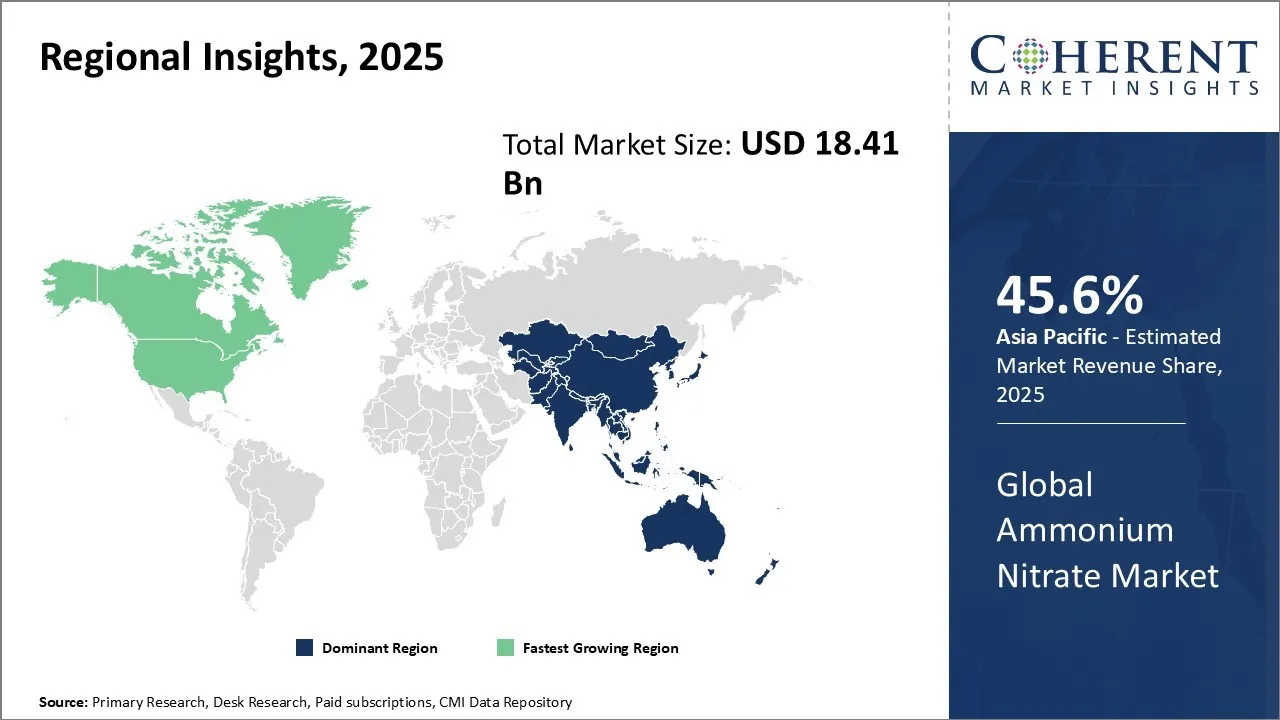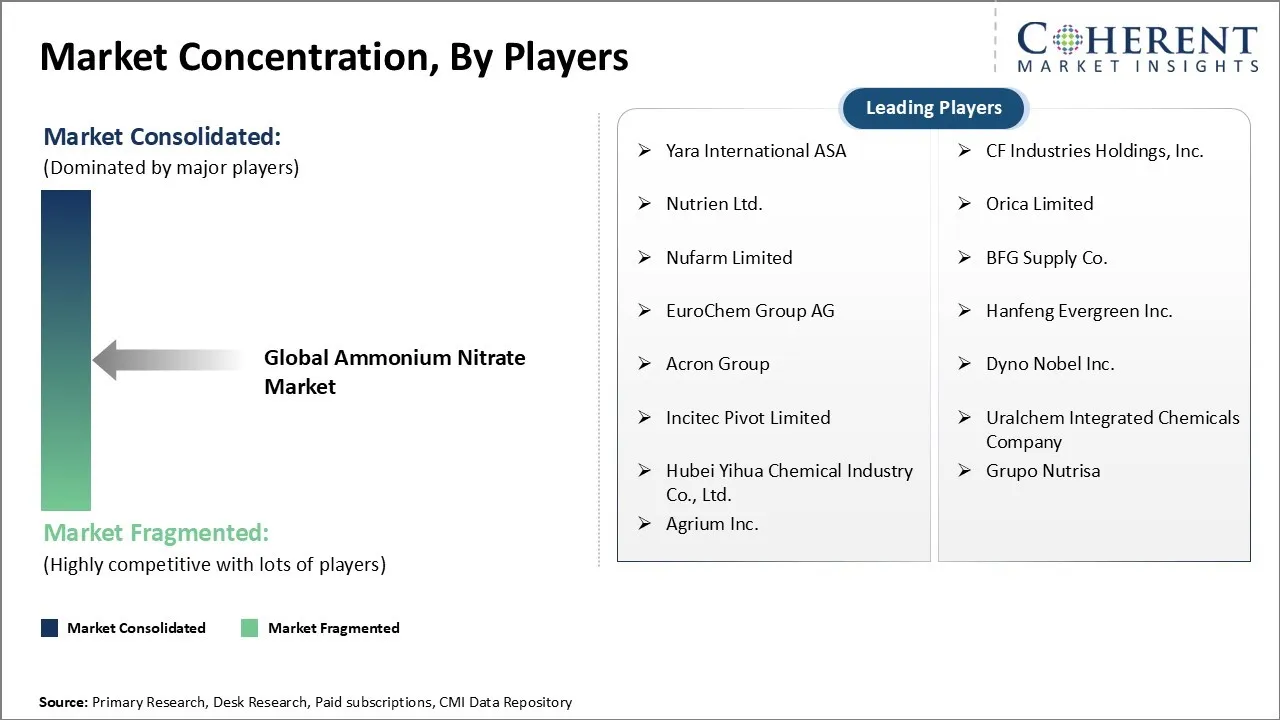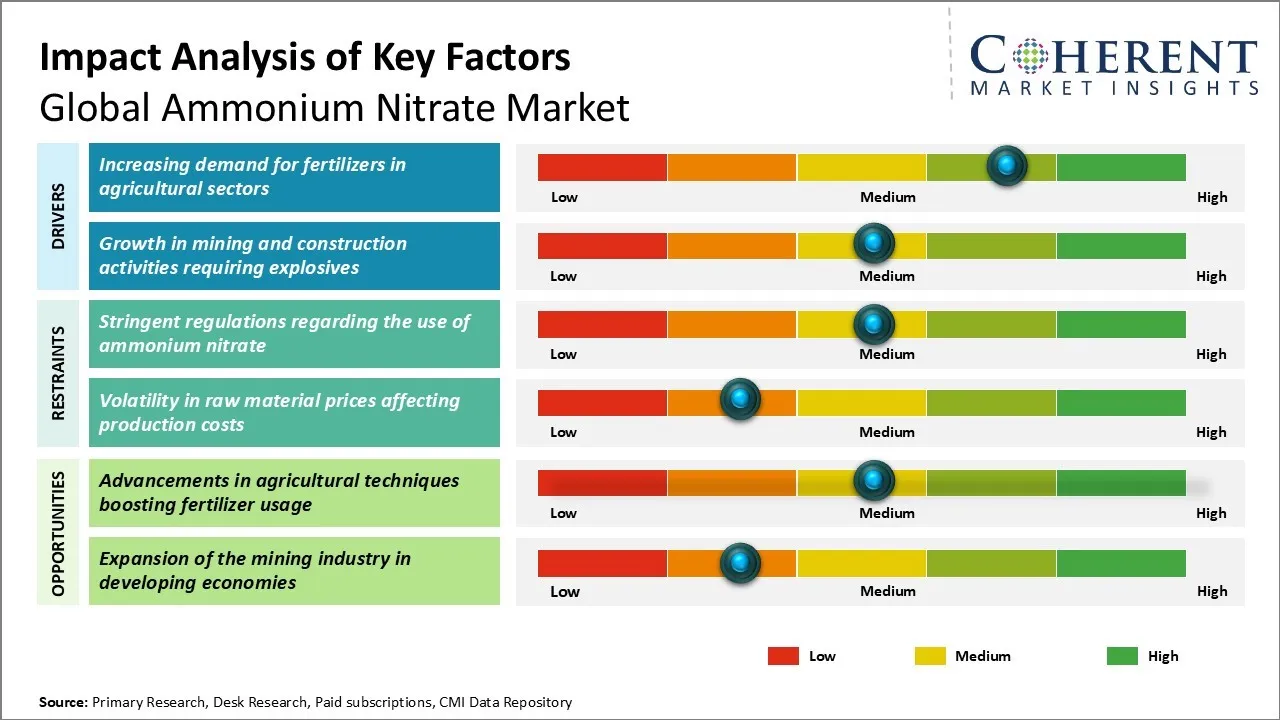The global ammonium nitrate market is estimated to be valued at USD 18.41 Bn in 2025 and is expected to reach USD 25.21 Bn by 2032, exhibiting a compound annual growth rate (CAGR) of 4.6% from 2025 to 2032.
Key Takeaways of the Ammonium Nitrate Market:
Market Overview:
The growth of the fertilizer industry is driving the demand for ammonium nitrate as it is a highly consumed fertilizer. Its wide usage in industries, such as mining and construction, is also fueling the market growth. The increasing world population is putting pressure on agricultural production to meet the growing demand for food. This is expected to increase the consumption of fertilizers for higher agricultural yield, in turn, driving the demand for ammonium nitrate. Furthermore, rising infrastructure development and mining activities across the globe are expected to contribute to the growth of this market during the forecast period.
Application Insights - Mining Dominates Due to Widespread Mining and Quarrying Activities
In terms of application, the mining segment is expected to contribute 31.5% share of the market in 2025, owing to its widespread use in mining and quarrying applications. Ammonium nitrate is a vital commodity used extensively as an oxidizing agent in mining and quarrying operations due to its stability and explosive properties when mixed with fuel oils. It aids in the fragmentation of rock materials and is safer to use and transport compared to conventional high explosives like dynamite. The ability of ammonium nitrate to effectively break down hard rock surfaces helps mining companies maximize ore extraction. Its high dissolving rate also makes it suitable for underground mining where space is limited.
End-use Industry Insights - Agricultural Demand Fuels Ammonium Nitrate Market Expansion
In terms of end-use industry, the agriculture segment is expected to hold 31.6% share of the market in 2025, owing to its widespread application as a nitrogen-based fertilizer. As a key input, ammonium nitrate helps raise yields by supplying nitrogen - a crucial nutrient - to crops. Population growth has increased global demand for food, augmenting fertilizer consumption and boosting the agricultural segment. Additionally, favorable government initiatives in developing regions to enhance farm outputs through fertilizer usage are benefiting market growth. Ammonium nitrate is also inexpensive and releases nitrogen gradually into the soil, making it ideal for high-value crops such as fruits, vegetables, and cereals.
Grade Insights - Agriculture Grade Enhancing Crop Yields and Soil Fertility
In terms of grade, the Agriculture Grade segment is expected to hold a dominant 34.5% share in the market in 2025, owing to its suitability for fertilizer applications. Agricultural grade ammonium nitrate contains lower levels of impurities and is calibrated specifically for soil applications. It has a nitrogen content optimized for plant needs and releases nutrients gradually to match crop-growth stages. The uniform dissolution and absorptive properties of agricultural grade make it ideal for enhancing soil fertility. It effectively raises the pH of acidic soils and supplies nitrogen when roots absorb it. This prevents losses due to leaching during rains. Farmers favor this grade for its crop-nourishing ability at low costs.

Need a Different Region or Segment? Customize now
Asia Pacific Ammonium Nitrate Market Trends
The Asia Pacific region is anticipated to dominate the ammonium nitrate market, securing a 45.6% share by the end of 2025. This leadership is driven by rapid growth in countries like China and India, where expanding manufacturing and agricultural sectors are increasing demand. Government efforts to modernize agriculture and significant investments in public infrastructure are further boosting market growth.
North America Ammonium Nitrate Market Trends
North America is projected to hold 23.5% of the ammonium nitrate market share by the end of 2025. North America is expected to exhibit the fastest growth in the market which can be attributed to robust demand from key end-use industries such as construction and mining. The region is home to some of the largest mining companies globally who rely heavily on ammonium nitrate for their operations. Moreover, government support for infrastructure growth is boosting construction activities, thereby favoring market growth.
Ammonium Nitrate Market Outlook for Key Countries
U.S. Ammonium Nitrate Market Trends
The U.S. is a major player in the ammonium nitrate market, driven by high demand from the agriculture and mining sectors. The market is expected to grow due to government initiatives aimed at increasing domestic fertilizer production, particularly in response to rising input costs. The Biden administration's proposal of a US$ 500 million grant to enhance domestic fertilizer production, including ammonium nitrate, is a significant development.
China Ammonium Nitrate Market Trends
China stands as the largest consumer of ammonium nitrate, primarily due to its extensive agricultural sector and the government's emphasis on enhancing food security and agricultural productivity. Increased investments in modern agricultural techniques and infrastructure further boosted fertilizer consumption. A key contributor to this market is San Corporation, China's leading exporter of ammonium nitrate. San Corporation operates a large-scale factory with an annual production capacity of approximately 1.2 million tons of ammonium nitrate. The company offers a range of products, including Porous Prilled Ammonium Nitrate (PPAN) and Chemical Pure Ammonium Nitrate (CPAN), which are essential for both agricultural and industrial applications.
India Ammonium Nitrate Market Trends
The Indian ammonium nitrate market is experiencing significant growth, bolstered by government initiatives aimed at enhancing agricultural productivity. The National Mission for Sustainable Agriculture (NMSA) focuses on promoting the use of nitrogenous fertilizers, including ammonium nitrate, to achieve self-sufficiency in food production. This focus led to increased adoption of modern agricultural techniques and a corresponding rise in fertilizer consumption. A key contributor to this market expansion is Deepak Fertilisers and Petrochemicals Corporation Limited (DFPCL), a prominent Indian manufacturer of industrial and agricultural chemicals.
Brazil Ammonium Nitrate Market Trends
Brazil is experiencing growth in its ammonium nitrate market, driven by increasing demand for fertilizers in the agricultural sector. The government's promotion of sustainable agricultural practices has further encouraged the use of ammonium nitrate. A significant contributor to this market is Yara International, a global leader in crop nutrition solutions. Yara has established a strong presence in Brazil, notably through the acquisition of local fertilizer companies and the development of production facilities.
Russia Ammonium Nitrate Market Trends
Russia is a significant producer and exporter of ammonium nitrate, with a strong focus on the agricultural sector. The market experienced growth due to rising global demand for fertilizers. The Russian government has been investing in the modernization of production facilities to enhance efficiency and sustainability in ammonium nitrate production. In 2023, Uralchem accounted for 22.4% of Russia's ammonium nitrate production, with facilities capable of producing over 3 million tonnes annually. The company has been actively modernizing its production processes to improve efficiency and sustainability, aligning with governmental objectives to enhance the country's fertilizer production capabilities

Get actionable strategies to beat competition: Request sample copy
Key Developments:
Top Strategies Followed by Global Ammonium Nitrate Market Players
Emerging Startups - Ammonium Nitrate Industry Ecosystem
Ammonium Nitrate Market Report Coverage
| Report Coverage | Details | ||
|---|---|---|---|
| Base Year: | 2024 | Market Size in 2025: | US$ 18.41 Bn |
| Historical Data for: | 2020 To 2024 | Forecast Period: | 2025 To 2032 |
| Forecast Period 2025 to 2032 CAGR: | 4.6% | 2032 Value Projection: | US$ 25.21 Bn |
| Geographies covered: |
|
||
| Segments covered: |
|
||
| Companies covered: |
Yara International ASA, CF Industries Holdings, Inc., Nutrien Ltd., Orica Limited, Nufarm Limited, BFG Supply Co., EuroChem Group AG, Hanfeng Evergreen Inc., Acron Group, Dyno Nobel Inc., Incitec Pivot Limited, Uralchem Integrated Chemicals Company, Hubei Yihua Chemical Industry Co., Ltd., Grupo Nutrisa, and Agrium Inc. |
||
| Growth Drivers: |
|
||
| Restraints & Challenges: |
|
||
Uncover macros and micros vetted on 75+ parameters: Get instant access to report

Discover market dynamics shaping the industry: Request sample copy
Ammonium Nitrate Market Growth Factors
Increasing demand for fertilizers in agricultural sectors
The global population is rising rapidly with each passing year. With more mouths to feed, the demand for food is growing exponentially as well. However, the amount of agriculturally viable land available is limited. Thus, to meet the spiraling food requirements, farmers are compelled to maximize crop yields from their existing farmlands. Ammonium nitrate has emerged as one of the most important fertilizers used globally to boost agricultural productivity. It supplies both nitrogen and oxygen, two primary nutrients essential for healthy plant growth. When applied appropriately to farms, ammonium nitrate vastly improves crop yields. This is driving strong need for high-performance fertilizers like ammonium nitrate all over the world. The demand is the strongest in populous developing regions of Asia Pacific, Africa, and Latin America where per capita arable land availability is the lowest.
Market Challenge - Stringent regulations regarding the use of ammonium nitrate
This market has been facing stringent regulations regarding the use and handling of ammonium nitrate across various countries. Many governments have imposed strict norms for controlling the availability and end-use of ammonium nitrate to prevent its misuse for illegal activities. Several terrorist attacks in the past few decades have been carried out using improperly stored or handled ammonium nitrate. This has resulted in many countries introducing rigorous controls around procurement, storage, transport, and usage of ammonium nitrate. The regulations require manufacturers and handlers to obtain special licenses and permits. Additionally, the storage facilities are also required to install sophisticated security and monitoring systems. The stringent regulations have increased the overall cost of operations for ammonium nitrate players. Non-compliance with the regulatory standards can lead to hefty penalties and shutting down of manufacturing or storage units. The complex regulatory landscape poses a major challenge for the smooth functioning of the global ammonium nitrate market.
Market Opportunity - Advancements in Agricultural Techniques Boosting Fertilizer Usage
Advancements in agricultural techniques and practices are positively influencing the demand for ammonium nitrate in the market. The rising global population has increased the demand for food, leading farmers to boost crop production. Advanced farming techniques such as precision farming, crop rotation, and proper soil management are enabling farmers to maximize agricultural yields. This requires increased usage of fertilizers including ammonium nitrate. Adoption of these new agricultural practices is driving the consumption of ammonium nitrate-based fertilizers. Fertilizer usage is also growing in developing countries where governments are taking initiatives to enhance farm productivity.
Share
Share
About Author
Yash Doshi is a Senior Management Consultant. He has 12+ years of experience in conducting research and handling consulting projects across verticals in APAC, EMEA, and the Americas.
He brings strong acumen in helping chemical companies navigate complex challenges and identify growth opportunities. He has deep expertise across the chemicals value chain, including commodity, specialty and fine chemicals, plastics and polymers, and petrochemicals. Yash is a sought-after speaker at industry conferences and contributes to various publications on topics related commodity, specialty and fine chemicals, plastics and polymers, and petrochemicals.
Missing comfort of reading report in your local language? Find your preferred language :
Transform your Strategy with Exclusive Trending Reports :
Frequently Asked Questions
Joining thousands of companies around the world committed to making the Excellent Business Solutions.
View All Our Clients
US Reciprocal Tax Impact Analysis On Ammonium Nitrate Market
Stay updated on tariff changes with expert insights and timely information